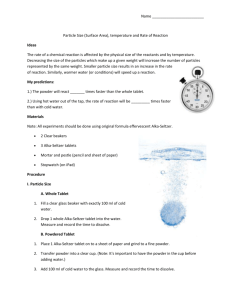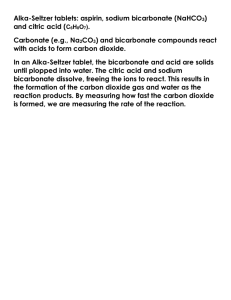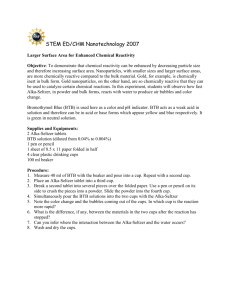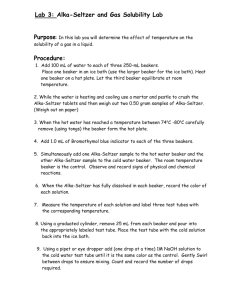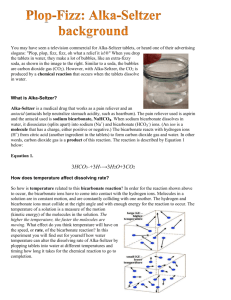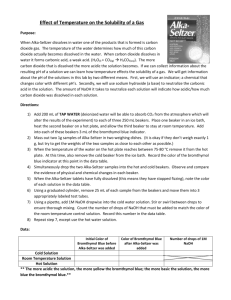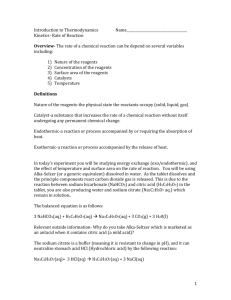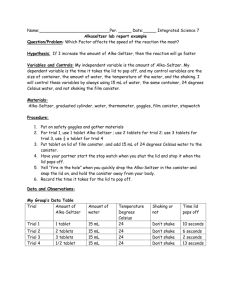doc - Ms. Eng`s Chemistry
advertisement
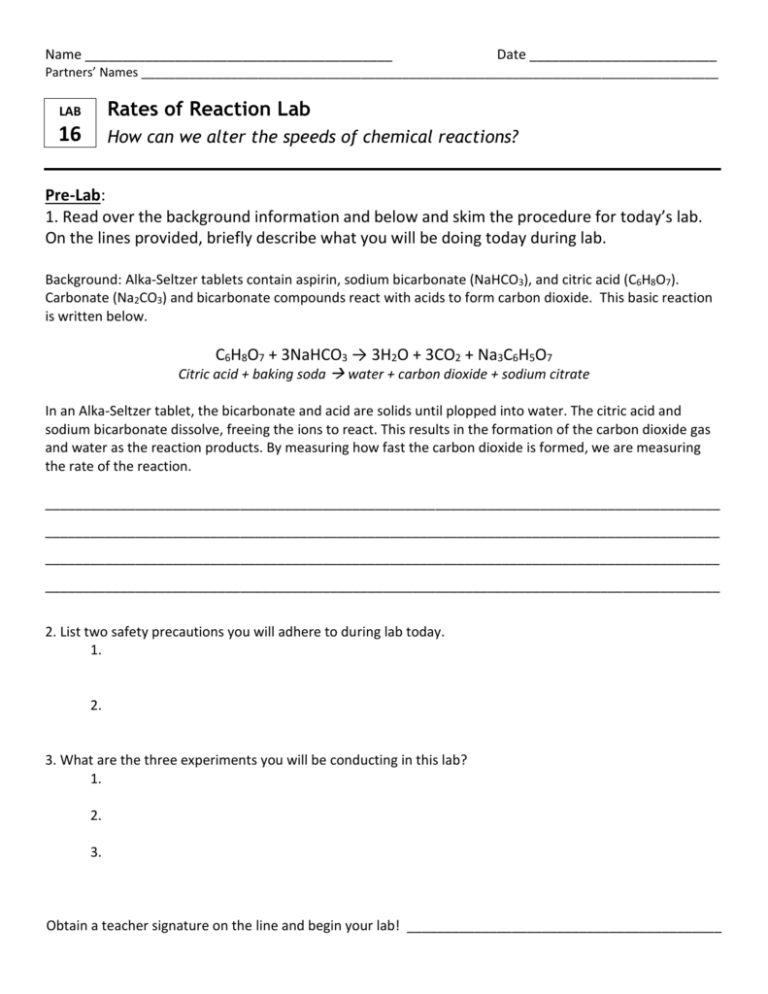
Name _________________________________________ Date _________________________ Partners’ Names ____________________________________________________________________________________ LAB Rates of Reaction Lab 16 How can we alter the speeds of chemical reactions? Pre-Lab: 1. Read over the background information and below and skim the procedure for today’s lab. On the lines provided, briefly describe what you will be doing today during lab. Background: Alka-Seltzer tablets contain aspirin, sodium bicarbonate (NaHCO3), and citric acid (C6H8O7). Carbonate (Na2CO3) and bicarbonate compounds react with acids to form carbon dioxide. This basic reaction is written below. C6H8O7 + 3NaHCO3 → 3H2O + 3CO2 + Na3C6H5O7 Citric acid + baking soda water + carbon dioxide + sodium citrate In an Alka-Seltzer tablet, the bicarbonate and acid are solids until plopped into water. The citric acid and sodium bicarbonate dissolve, freeing the ions to react. This results in the formation of the carbon dioxide gas and water as the reaction products. By measuring how fast the carbon dioxide is formed, we are measuring the rate of the reaction. __________________________________________________________________________________________ __________________________________________________________________________________________ __________________________________________________________________________________________ __________________________________________________________________________________________ 2. List two safety precautions you will adhere to during lab today. 1. 2. 3. What are the three experiments you will be conducting in this lab? 1. 2. 3. Obtain a teacher signature on the line and begin your lab! __________________________________________ Name _________________________________________ Date _________________________ Partners’ Names ____________________________________________________________________________________ Experiment 1: The Effects of Temperature on Rate of Reaction 1. In order for a chemical reaction to occur, the particles, atoms or ions, which are REACTANTS, must physically come into contact with one another. Anything that increases the frequency of these encounters will increase the rate at which PRODUCTS are formed. 2. The rate of a chemical reaction can be increased by increasing the temperature of these reactants. My predictions: Using hot water, the rate of reaction will be _________ times faster than at 0 degrees C. 3 beakers Thermometer 3 Alka-Seltzer tablets Stopwatch Source of hot water Ice cubes Graph paper A. Hot Water 1. Run water from the hot tap until it is as hot as possible. Fill a beaker with exactly 150 ml of hot water. 2. Use the thermometer to take the temperature and record it on your data sheet (last page). 3. Remove 1 Alka-Seltzer tablet from its package. Drop it into water. Measure the time required for tablet to fully dissolve. Be prepared to start and stop on time. The reaction will take less than 15 sec. Record the time. B. Room Temperature Water 1. Fill a beaker with exactly 150 ml of room temperature or lukewarm water. 2. Use the thermometer to take the temperature and record it on your data sheet. 3. Drop 1 Alka-Seltzer tablet into the water. Measure the time required for the reaction to be completed. Record the time. C. Cold Water 1. Fill a beaker with 75 ml of water and add enough ice to adjust the level to 150ml. Stir the ice water for about 15 seconds so the temperature will stabilize. 2. Use the thermometer to take the temperature and record it on your data sheet. (Leave the ice cubes in the water) 3. Drop 1 Alka-Seltzer tablet into the water. Measure the time required for the reaction to be completed. Record the time. Data analysis: 1. Make a graph of your data points (water temperature vs. time to fully dissolve) to show the effect of temperature on Rate of Reaction. 2. As the temperature increases, the rate of reaction _____________________________. 3. According to your graph, at a temperature of 10 degrees C, it would take about ______ seconds for 1 Alka-Seltzer tablet to react with 150 ml of water. 4. If the temperature is doubled from 20 degrees C to 40 degrees C, the time for the rate of reaction _________________by approximately _______. 5. Using hot tap water, the rate was ______ times faster than at 0 degrees C. Name _________________________________________ Date _________________________ Partners’ Names ____________________________________________________________________________________ Experiment 2: The Effect of Particle Size on Rate of Reaction 1. The rate of a chemical reaction is affected by the physical size of the reactants. Decreasing the size of the particles which make up a given weight will increase the number of particles represented by the same weight. Aka… Smaller particle size results in an increase in the rate of reaction because the surface area of the reactant has been increased. My predictions: The powder will react _______ times faster than the whole tablet. 3 beakers Crushing tool 3 Alka-Seltzer tablets Stopwatch Procedure A. Whole Tablet 1. Fill a beaker with exactly 150 ml of room temperature or lukewarm water. 2. Drop 1 whole Alka-Seltzer tablet into the water. Measure and record the time to dissolve. B. Tablet Broken into ~8 Pieces 1. Place 1 Alka-Seltzer tablet onto a sheet of paper and break into approximately 8 pieces of about equal size. 2. Fill a beaker with exactly 150ml of room temperature or lukewarm water. 3. Slide broken tablet into the water from the sheet. Measure and record the time to dissolve. C. Powdered Tablet 1. Place 1 Alka-Seltzer tablet onto a sheet of paper and cover it. Use a tool of your choice to crush it into a fine powder. 2. Transfer powder into a beaker. (Note: It's important to have the powder in the beaker before adding water.) 3. Add 150 ml of water to the glass. Measure and record the time to dissolve. Data Analysis: 1. As particle size decreases, the rate of reaction _______________. 2. The rate of reaction for the powder was ___________ times faster than for the whole tablet. 3. As particle size decreases, the total surface area of a reactant ________________. As a result, the probability of interactions between atoms/ions ________________, and the rate of reaction ___________________. 4. Particle size appears to have _______________ (less or more) of an effect on the rate of reaction than temperature. Name _________________________________________ Date _________________________ Partners’ Names ____________________________________________________________________________________ Experiment 3: Effect of Pressure on the Rate of Chemical Reactions 1. If any of the products or reactants involved in a chemical reaction are gases, the rate of reaction will decrease as pressure on the system is increased. When water reacts with Alka-Seltzer, one of the products of the reaction is carbon dioxide gas. 2. In this investigation, pressure inside the reaction chamber will be controlled by slowing down the rate at which the gas is allowed to escape from the reaction chamber. The effect that an increase in pressure has on the Rate of Reaction will be measured. Safety goggles Stopper 2 test tubes 2 Alka-Seltzer tablets Procedure A. Rate of Reaction at Normal Pressure 1. Fill a test tube 1/2 full of water. The water should be at about room temperature. 2. Break an Alka-Seltzer tablet in half and drop the pieces into the test tube. 3. Measure the time required for the reaction between the Alka-Seltzer and water to be completed. Record the time. B. Rate of Reaction Under Increased Pressure - PUT ON YOUR SAFETY GOGGLES! 1. Fill the test tube 1/2 full of water. The water should be about room temperature. 2. Break an Alka-Seltzer tablet in half. Drop the pieces into the test tube. 3. Immediately insert and hold the “stopper” in the end of the test tube to slow down the escape of carbon dioxide gas. The pressure being exerted upon the reactants inside the test tube is equal to the pressure you feel being exerted against the stopper. Note: Do not try to stop all of the gas from escaping! If you try to do so, the test tube will break. Just slow down the escaping gas as pressure builds up inside of the test tube. Avoid a total "blow-out" of the liquid from the tube by releasing enough pressure on the stopper from time to time to let gas and liquid "squeeze" its way past the cork, in controlled amounts. 4. When gas bubbles are no longer visible in the liquid contained in the test tube, consider the reaction to be over. Observe and record the time of the reaction. 5. Release the stopper completely. Observe and record what happens to the remaining Alka-Seltzer. Data Analysis: 1. What effect does increase in pressure have on the rate of a gas producing reaction? 2. What do you think would happen to the rate of the reaction if a vacuum (no pressure) was applied? Name _________________________________________ Date _________________________ Partners’ Names ____________________________________________________________________________________ Data: Record measurements with units in the data tables. All graphs should have a title and labeled axes. Experiment 1: Water Temperature Time for Reaction Completion Experiment 2: Tablet Size Time for Reaction Completion Name _________________________________________ Date _________________________ Partners’ Names ____________________________________________________________________________________ Experiment 3: Pressure Time for Reaction Completion Observations: Data Analysis Questions 1. Summarize what you learned about rates of reactions from this lab. 2. Would you do anything differently to get better results if you repeated this lab? 3. Can you think of another variable (besides temperature, particle size, or pressure) that might affect the rate of a reaction?
